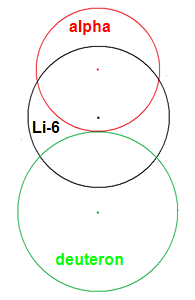Li-6 Model
 The radius of the black circle
The radius of the black circleis the Li-6 radius.
larger image
Copyright © 2009 by Phillip E. Fraley
Three models with an alpha as one component and either a deuteron (Li-6), triton (Li-7) or helion (Be-7) as the other are stable or semi-stable (Be-7 has a half-life of 52 days).
Figure 8
Li-6 Model The radius of the black circle
The radius of the black circle
is the Li-6 radius.
larger image
r = 0.853 61/3 = 1.550 fm
4 M 2r 1/3 v1 + 2 M 2r 2/3 2v1 = √2ћ
Dividing by M rp c = ћ: 8 r/rp v1/c = √2
v1 = 0.0240 c. v2 = 2 v1 = 0.0480 c
kinectic energy: 1/2 4 M v12 + 1/2 2 M v22
Dividing by M c2 = 938.259 MeV yields 3.229 MeV total
Figure 9
Li-7 or Be-7 Model The radius of the black circle
The radius of the black circle
is the Li-7 or Be-7 radius.
larger image
r = 0.853 61/3 = 1.632 fm
4 M 2r 3/7 v1 + 3 M 2r 4/7 4/3v1 = √2ћ
Dividing by M rp c = ћ: 8 r/rp v1/c = √2
v1 = 0.02275 c. v2 = 4/3 v1 = 0.03033 c
kinectic energy: 1/2 4 M v12 + 1/2 3 M v22
Dividing as above yields 2.265 MeV total
There are five 'dumbbell' models: deuteron, Li-6, Li-7, Be-7 and possibly Be-9, Be-9 to be discussed later. Li-7 is the only one without an soe+ and also is the only one where the magnitude of the binding energy (2.47 MeV) is approximately equal to the kinectic energy (expected if the potential is 1/r and is central).
The soe+ radius is 0.7 times the green deuteron radius of Fig. 8 and is only slightly smaller than the green helion radius of Fig. 9.